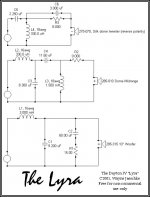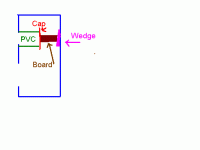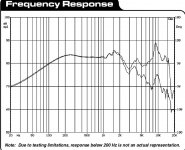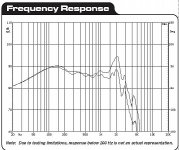If the 5.25 in mid is unchambered, as has been established, there is the possiblity that it is working as a passive radiator for the 12" woofer/box combo. If you put two nonidentical ports or PRs into one chamber, the Port or PR which would serve to tune the box to a higher frequency will prevail and the box tuning will go up. In other words, if the 5.25 in mid is acting as a passive radiator tuning the box to 50 or 60 Hz, then the 4" tube which Tubehead Johnny thinks is tuning his box is doing little or nothing at all.
I'll be most likely getting a chambered mid, like the DC50F-8 2" Dome. So any passive radiator effect will be gone. The only reason why a bought that 5.25" woofer in the first place was to be able to crossover the woofer super low (like 80 Hz). It originally had a 11 mH coil (if I remember correctly), but the ringing is horrible.
Again, don't be condescending. I never claimed to be a confident speaker builder or even a bad one for that matter. That's why I started this thread, to learn. It's not going to help me or anyone else here.
With all respect, I did not think I was being condescending. I have taken no Electrical Engineering courses, am entirely self-taught, and unless I see something in the member's posts which indicate otherwise I assume he is a beginner with little or no test equipment.
The principle of the higher tuned port "trumping" the lower tuned port is something even experienced speakers builders are often not aware of.
I gave the link to the freeware audio generator because I found it useful, and a suggestion on how to use it in case the speakers, which are large, are in a different room from your computer. It was meant as a helpful suggestion. I also thought the test was a nice way to establish right now if the mid was acting as a PR and robbing you of output at 40 Hz, something I thought you would want to know while waiting for the new mid to arrive.
My previous remark about how you might prefer a slightly elevated bass since you are a bass player was based on my experience that some people like the bass elevated, if fact JBL used to sell speakers with a purposely elevated bass at one time.
The principle of the higher tuned port "trumping" the lower tuned port is something even experienced speakers builders are often not aware of.
I gave the link to the freeware audio generator because I found it useful, and a suggestion on how to use it in case the speakers, which are large, are in a different room from your computer. It was meant as a helpful suggestion. I also thought the test was a nice way to establish right now if the mid was acting as a PR and robbing you of output at 40 Hz, something I thought you would want to know while waiting for the new mid to arrive.
My previous remark about how you might prefer a slightly elevated bass since you are a bass player was based on my experience that some people like the bass elevated, if fact JBL used to sell speakers with a purposely elevated bass at one time.
TubeHead Johnny said:
I'll be most likely getting a chambered mid, like the DC50F-8 2" Dome. So any passive radiator effect will be gone. The only reason why a bought that 5.25" woofer in the first place was to be able to crossover the woofer super low (like 80 Hz). It originally had a 11 mH coil (if I remember correctly), but the ringing is horrible.
Again, don't be condescending. I never claimed to be a confident speaker builder or even a bad one for that matter. That's why I started this thread, to learn. It's not going to help me or anyone else here.
I'm not sure if you considered my posts condescending, never meant them that way, but if I see something wrong I'm going to say it because you asked for help after all.
I would actually go for a cone mid with a chamber which will allow you to use a lower crossover point, say 200 to 400 Hz, without the rolloff rate being so critical. The 2" will work but it will not give you as much flexibility in design.
Pete B.
I guess I'm too sensitive!
PB2 & kelticwizard,
Have you seen the Lyra XO? Do you think the 800-850 Hz point is too high? pwater believes I can use it w/o any mods and no change in performance.
~~John~~
PB2 & kelticwizard,
Have you seen the Lyra XO? Do you think the 800-850 Hz point is too high? pwater believes I can use it w/o any mods and no change in performance.
~~John~~
An externally hosted image should be here but it was not working when we last tested it.
Attachments
TJ:
Let me give you a quick history of crossover points so you can decide for yourself.
Back in the sixties and severnties when hifi was first getting popular, almost all speakers consisted of a 10 or 12 inch woofer, a 4 or 5 inch mid and a 1 inch tweeter. Crossover points were usually 800 Hz and 2KHz or 4kHz. They sounded pretty good, and if you come across one at a tag sale and the surrounds aren't rotted, they would sound pretty good still.
In the eighties, though, a new idea took hold. Start the midrange at the bottom of the vocal range. Middle A on the piano is 440 Hz, and the lowest most records have singing is an octave below that-220 Hz to 440 Hz. The reason for this is that while a crossover solves a lot of problems in sound reproduction, it also introduces some lesser problems on it's own. To avoid this, the reasoning goes, it is best to have the crossover point out of the vocal range, or have as few of them in the vocal range as possible. 800 Hz is right in the middle of the vocal range, so the feeling is that the crossover's effects are more hearable there.
The only problem with this approach is that the lower the crossover frequency, the more expensive the parts get. Both capacitors and inductors get big and expensive. So it becomes a tradeoff-do you want the advantage of having the midrange cover the whole vocal range, or do you want a more affordable crossover. That decision is up to you.
There is no right or wrong. For many years people listened to three ways with the mid coming in at 800 Hz and were quite happy with the sound. But most people feel that crossovers do degrade the sound somewhat at the crossover point.
Let me give you a quick history of crossover points so you can decide for yourself.
Back in the sixties and severnties when hifi was first getting popular, almost all speakers consisted of a 10 or 12 inch woofer, a 4 or 5 inch mid and a 1 inch tweeter. Crossover points were usually 800 Hz and 2KHz or 4kHz. They sounded pretty good, and if you come across one at a tag sale and the surrounds aren't rotted, they would sound pretty good still.
In the eighties, though, a new idea took hold. Start the midrange at the bottom of the vocal range. Middle A on the piano is 440 Hz, and the lowest most records have singing is an octave below that-220 Hz to 440 Hz. The reason for this is that while a crossover solves a lot of problems in sound reproduction, it also introduces some lesser problems on it's own. To avoid this, the reasoning goes, it is best to have the crossover point out of the vocal range, or have as few of them in the vocal range as possible. 800 Hz is right in the middle of the vocal range, so the feeling is that the crossover's effects are more hearable there.
The only problem with this approach is that the lower the crossover frequency, the more expensive the parts get. Both capacitors and inductors get big and expensive. So it becomes a tradeoff-do you want the advantage of having the midrange cover the whole vocal range, or do you want a more affordable crossover. That decision is up to you.
There is no right or wrong. For many years people listened to three ways with the mid coming in at 800 Hz and were quite happy with the sound. But most people feel that crossovers do degrade the sound somewhat at the crossover point.
Then again some people believe you should cross below 1khz where the ear is less sensitive and then not cross again, or if you do, high up in the treble. For these people a crossover at 2khz is right smack in the middle of the area that is most sensitive to the ear and should not be done. And 2khz is very much in the vocal region, this is where a lot of the harmonics are that contribute to intelligibility.
That said I've designed both ways, and while I'm most happy with the design using a dome mid crossed at 900hz & 4000hz, I don't believe this 900hz cross point contributed to it's success. Other factors did and the 900hz cross point was neither good nor bad, but simply didn't matter much.
The Lyra has gotten some praise, and I don't think you can go wrong with it considering the alternative of desiging something yourself-even with help from other for the crossover.
That said I've designed both ways, and while I'm most happy with the design using a dome mid crossed at 900hz & 4000hz, I don't believe this 900hz cross point contributed to it's success. Other factors did and the 900hz cross point was neither good nor bad, but simply didn't matter much.
The Lyra has gotten some praise, and I don't think you can go wrong with it considering the alternative of desiging something yourself-even with help from other for the crossover.
kelticwizard said:TJ:
...most people feel that crossovers do degrade the sound somewhat at the crossover point.
I agree, I am currently a fan of the fullrange for its filterless properties.
Would you also agree that in a design with his starting point, the utmost in fidelity is not paramount? Take note, TubeHead Johnny, this is not condescention, your speaker will sound great when it's done. The point is that my admittedly non-golden ear has come across very few x-o layouts that I could hear, and though I've never listenned to the Lyras, I'm Sure Wayne J did a good job with the x-o. I fully understand that kelticwizard is simply explaining the theory and history, but as it pertains to this thread, I'm sure that a Lyra copy will be just fine for TubeHead Johnny, and at least miles ahead of what he's got now.
That being said, a cone midrange can make all the difference when used as a very wide band (~80Hz to 8kHz), and x-o design is simplified with well-behaved inherant rolloffs. A simple short length of 6" PVC capped off and epoxied into each cab could do the trick. Any number of small Tang Bands or even the Dayton PA130 could fit the bill. Truth be told, I'm more interested in seeing if the Lyra can become a 12" three-way. A small breath of life into an oldie but a goodie?
OTOH, my ego wants me to design a x-o for TubeHead Johnny so he has a one-off, unique set-up...
EDIT I suppose I could have just ditto'd augerpro
TubeHead Johnny said:I guess I'm too sensitive!
PB2 & kelticwizard,
Have you seen the Lyra XO? Do you think the 800-850 Hz point is too high? pwater believes I can use it w/o any mods and no change in performance.
~~John~~An externally hosted image should be here but it was not working when we last tested it.
Your probably not going to get good results using a Xover designed for different speakers.
Speakers and Xovers are not plug and play, it takes a lot of work to get a 3 way right.
OTOH, my ego wants me to design a x-o for TubeHead Johnny so he has a one-off, unique set-up...
PLEASE do pwater! Maybe something slightly simpler using the 2" dome midrange. It's not that the Lyra is too hard to build. It's just that all those inductors and caps can get a bit pricey. I did a price list from Madisound and PE. About $150 and that's not using any premium parts.
Back in the sixties and severnties when hifi was first getting popular, almost all speakers consisted of a 10 or 12 inch woofer, a 4 or 5 inch mid and a 1 inch tweeter. Crossover points were usually 800 Hz and 2KHz or 4kHz. They sounded pretty good, and if you come across one at a tag sale and the surrounds aren't rotted, they would sound pretty good still.
These are the speakers I grew up with (I'm 47). I guess I'm getting set in my ways! I'll admit it, I'm narrow minded when it comes to speakers. I don't believe in towers or anything smaller than a 8" woofer. I never heard a small woofer that put out adequate bass (for my tastes anyway). I did the bi-amp thing but, my wife did nothing but complain about all the extra "boxes" needed. And subs are out of the question.
The older I get, the more narrow minded I become!
I've been thinking, and I remember being in the position that you are. Come up with a good idea, stumble upon a problem, ask for help, and get more than one suggestion that may be over your head. At this point, I would just say "pick a path", and it looks like you did. I will put something together using a dome mid and also try a cone mid to see if there's a substantial cost benefit. While I'm at it, you take a look into what it would take to retrofit the Dayton or HiVi 2" into the holes you've got, and see if it wouldn't be easier to install a back-chamber for a cone driver.
Just trying to weigh in the options....
How hard would it be to glue a short piece of 6" PVC behind the baffle? Will the epoxy alone be enough to bond and seal it? I don't think I can take the boxes apart. If I decide to go the cheap route, using the old driver, would I have to change the XO again if I don't like it, and would like to go for a better cone mid?
How hard would it be to glue a short piece of 6" PVC behind the baffle? Will the epoxy alone be enough to bond and seal it? I don't think I can take the boxes apart. If I decide to go the cheap route, using the old driver, would I have to change the XO again if I don't like it, and would like to go for a better cone mid?
TubeHead Johnny said:Just trying to weigh in the options....
How hard would it be to glue a short piece of 6" PVC behind the baffle? Will the epoxy alone be enough to bond and seal it?
A) I would think pretty easy once you take out the woofer and stick your hand through the resulting hole.
B) Why not? You can always silicone around the glue joint the next day after it dries.
PS: If you want to keep pressure on the midrange chamber overnight while drying, I would suggest that before you add the epoxy, cut a piece of wood that you can wedge between the back of the mid chamber to be glued and the internal back wall of the enclosure. Then add the expoxy and wedge the piece in there. I would use a board, if necessary, between the wedge and the end cap.
Or you can use whatever method you prefer.
Here is a little scribble I came up with to illustrate how I would approach it.
Or you can use whatever method you prefer.
Here is a little scribble I came up with to illustrate how I would approach it.
Attachments
You posted your last post before my pic. Looks like we are thinking the same thing.
Volume inside the cab may or may not be critical depending on whether you want an "infinite baffle" enclosure or a closed box in which the air in the enclosure is less than the Vas of the mid. Let me check some specs for typical 5" mids with an Fs of 50 or 60 and get back to you in a moment.
Volume inside the cab may or may not be critical depending on whether you want an "infinite baffle" enclosure or a closed box in which the air in the enclosure is less than the Vas of the mid. Let me check some specs for typical 5" mids with an Fs of 50 or 60 and get back to you in a moment.
On second thought, do you have any published Thiele-Small specs for that aluminum cone mid you are using now?
And did you decide on a crossover point?
Once the PVC is glued in, you can saw it off I suppose, but I would think it would be a good idea to make it a little extra large so blocks can be glued in to reduce volume later if need be.
And did you decide on a crossover point?
Once the PVC is glued in, you can saw it off I suppose, but I would think it would be a good idea to make it a little extra large so blocks can be glued in to reduce volume later if need be.
Dayton recommends crossing the tweeter at 2 KHz, so that would probably be the best way to go.
T/S:
*Power handling: 30 watts RMS/50 watts max *VCdia: 1" *Le: .9 mH *Znom: 8 ohms *Re: 6.15 ohms *Frequency range: 50-15,000 Hz *Fs: 53 Hz *SPL: 85 dB 1W/1m *Vas: .25 cu. ft. *Qms: 2.40 *Qes: .57 *Qts: .46 *Xmax 3 mm
T/S:
*Power handling: 30 watts RMS/50 watts max *VCdia: 1" *Le: .9 mH *Znom: 8 ohms *Re: 6.15 ohms *Frequency range: 50-15,000 Hz *Fs: 53 Hz *SPL: 85 dB 1W/1m *Vas: .25 cu. ft. *Qms: 2.40 *Qes: .57 *Qts: .46 *Xmax 3 mm
Attachments
Well, if you're going to cross over at 200 or so with this mid, the mid seems to be somewhat less efficient than the Dayton woofer. Parts Express says the Dayton's response is not accurate below 200 Hz, but at 200 Hz it apears to be 89 dB or so and the mids look around 85 or 84.
Attachments
Something like this can make your life a lot easier given the smooth response:
http://www.madisound.com/catalog/product_info.php?manufacturers_id=143&products_id=8499
Pete B.
http://www.madisound.com/catalog/product_info.php?manufacturers_id=143&products_id=8499
Pete B.
- Status
- This old topic is closed. If you want to reopen this topic, contact a moderator using the "Report Post" button.
- Home
- Loudspeakers
- Multi-Way
- No Bottom E?



